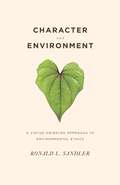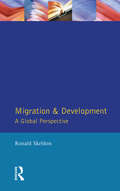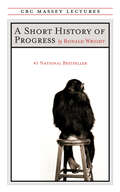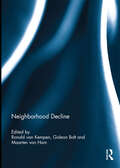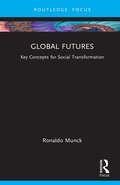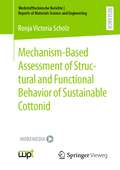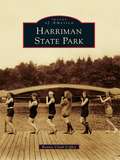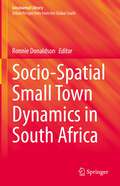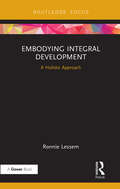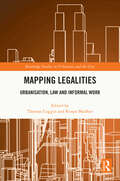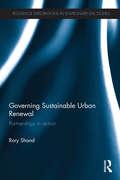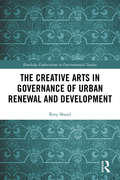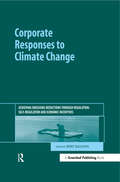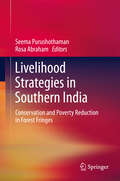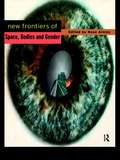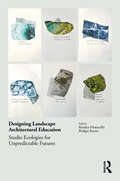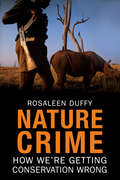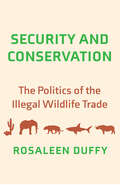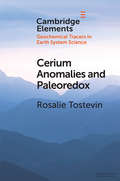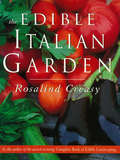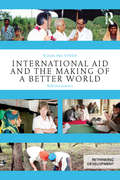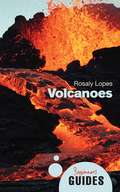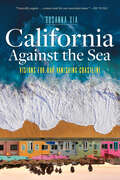- Table View
- List View
Character and Environment: A Virtue-Oriented Approach to Environmental Ethics
by Ronald SandlerVirtue ethics is now widely recognized as an alternative to Kantian and consequentialist ethical theories. However, moral philosophers have been slow to bring virtue ethics to bear on topics in applied ethics. Moreover, environmental virtue ethics is an underdeveloped area of environmental ethics. Although environmental ethicists often employ virtue-oriented evaluation (such as respect, care, and love for nature) and appeal to role models (such as Henry Thoreau, Aldo Leopold, and Rachel Carson) for guidance, environmental ethics has not been well informed by contemporary work on virtue ethics. With Character and Environment, Ronald Sandler remedies each of these deficiencies by bringing together contemporary work on virtue ethics with contemporary work on environmental ethics. He demonstrates the many ways that any ethic of character can and should be informed by environmental considerations. He also develops a pluralistic virtue-oriented environmental ethic that accommodates the richness and complexity of our relationship with the natural environment and provides effective and nuanced guidance on environmental issues. These projects have implications not only for environmental ethics and virtue ethics but also for moral philosophy more broadly. Ethical theories must be assessed on their theoretical and practical adequacy with respect to all aspects of the human ethical situation: personal, interpersonal, and environmental. To the extent that virtue-oriented ethical theory in general, and Sandler's version of it in particular, provides a superior environmental ethic to other ethical theories, it is to be preferred not just as an environmental ethic but also as an ethical theory. Character and Environment will engage any reader with an interest in environmental ethics, virtue ethics, or moral philosophy.
Migration and Development: A Global Perspective (Longman Development Studies)
by Ronald SkeldonThe first text that specifically links both international and internal migration with development at a global level. The world is divided into a series of functionally integrated development zones which are identified, not simply on the basis of their level of development, but also through their spatial patterns and historical experience of migration. Migration and Development stresses the importance of migration in discussing regional, rather than simply country, differences. These variations in mobility are placed within the context of a global hierarchy, although regional, national and local cultural and social conditions are certainly not ignored in this wide-ranging work.
A Short History of Progress: Fifteenth Anniversary Edition (The CBC Massey Lectures)
by Ronald WrightNow more relevant than ever, Ronald Wright’s #1 national bestseller, A Short History of Progress. The fifteenth anniversary edition includes a new introduction warning of the accelerating patterns of progress and disaster.Each time history repeats itself, so it’s said, the price goes up. The twentieth century was a time of runaway growth in human population, consumption, and technology, placing a colossal load on all natural systems, especially earth, air, and water — the very elements of life. The most urgent questions of the twenty-first century are: Where will this growth lead? Can it be consolidated or sustained? And what kind of world is our present bequeathing to our future?In his #1 national bestseller A Short History of Progress Ronald Wright argues that our modern predicament is as old as civilization, a 10,000-year experiment we have participated in but seldom controlled. Only by understanding the patterns of triumph and disaster that humanity has repeated around the world since the Stone Age can we recognize the experiment’s inherent dangers, and, with luck and wisdom, shape its outcome. In his new introduction to the fifteenth anniversary edition, Wright looks at the past fifteen years of human innovation — and asks whether we can still get the future right.
Neighborhood Decline
by Ronald van Kempen, Gideon Bolt and Maarten van HamThe global financial and economic crisis that hit the world since 2008 has affected the lives of many people all over the world and resulted in declining incomes, rising unemployment, foreclosures, forced residential moves, and cut-backs in government expenditure. The extent to which the crisis has affected urban neighborhoods and has led to rising intra-urban inequalities, has not yet received much attention. The implemented budget cuts and austerity programs of national and local governments are likely to have hit some neighborhoods more than others. The authors of this this book, which come from a variety of countries and disciplines, show that the economic crisis has affected poor neighborhoods more severely than more affluent ones. The tendency of the state to retreat from these neighborhoods has negative consequences for their residents and may even nullify the investments that have been made in many poor neighborhoods in the recent past. This book was originally published as a special issue of Urban Geography.
Global Futures: Key Concepts for Social Transformation (Routledge Critical Development Studies)
by Ronaldo MunckGlobal Futures: Key Concepts for Social Transformation provokes us to rethink some of the key words and concepts which define the current global order. Prompted by crises around the world, it seeks to re-energise our desire for a better future.The book takes seven key concepts from the new global studies and considers how they are used and whether they are adequate for addressing the twenty-first century's increasingly complex global order. The topics covered include widely used concepts such as development, modernity, history, and politics, as well as more unusual themes such as desire, complexity, and alternative futures. The core message of this book is that we need to grasp the complex and contradictory reality behind these important concepts in order to foster a new way of thinking, seeing, and acting for a future fit for human purpose.Written by Ronaldo Munck, a key social theorist and social activist with a Latin American and European background, this book will be perfect for students and researchers of sociology, politics, international relations, and global development.
Mechanism-Based Assessment of Structural and Functional Behavior of Sustainable Cottonid (Werkstofftechnische Berichte │ Reports of Materials Science and Engineering)
by Ronja Victoria ScholzRonja Victoria Scholz assesses the performance of cellulose-based Cottonid for implementation as sustainable construction material. Quasi-static and fatigue tests are performed in varying hygrothermal test conditions using mechanical testing systems in combination with integrable climate chambers. To investigate humidity-driven actuation properties, customized specimen holders are designed. Accompanying microstructural in situ experiments in analytical devices enable a profound understanding of effective material-specific damage and failure mechanisms. The findings are transferred into strength-deformation diagrams as well as Woehler curves, which enable a comparative evaluation of several process-related and environmental influencing factors and can directly be used for dimensioning of Cottonid elements for structural applications. The interpretation of thermoelastic material reponse during loading is used as scientific value for lifetime prediction. Comprehensive investigations on industrial standard materials as well as structurally optimized Cottonid variants provide a scientific basis for categorizing material’s structural and functional performance towards common technical plastics and wood.
Harriman State Park
by Ronnie Clark CoffeyOnce home to Native Americans and mountain settlers, Harriman State Park is today a 73-square-mile wilderness and recreation area lying 30 miles north of New York City. Offering over 200 miles of hiking trails, swimming, boating, fishing, and camping, it has been an oasis for city dwellers for 100 years. During the 1800s, the land was home to hardworking farmers, miners, and woodcutters. As the new century dawned, it evolved into a park of stunning beauty. Part of the Palisades Interstate Park System, it is the second-largest state park in New York.
Socio-Spatial Small Town Dynamics in South Africa (GeoJournal Library)
by Ronnie DonaldsonThis book explores small town geographical aspects by approaching them from a socio-spatial perspective. The contributions included in this book delve into a range of topics that have not been commonly studied before, such as white privilege, neglect of municipal infrastructure, collaborative governance, livelihoods in small-scale fisheries, housing provision, well-being in mining towns, studentification in rural contexts, election trends, and the historical development of small-town spas. The book adopts a socio-spatial point of view, providing a holistic understanding of the interplay between social and spatial factors within selected small town case studies. This approach sheds light on the socio-economic, political, and cultural dynamics that shape small towns. This localized perspective allows for a more targeted analysis of issues and potential solutions, taking into account the specific historical, cultural, and political contexts of small town South Africa. The edited volume serves as a valuable resource for academics, policymakers, practitioners, and anyone interested in understanding and improving small towns in South Africa.
The Collapse of the Eastern Mediterranean
by Ronnie EllenblumAs a 'Medieval Warm Period' prevailed in Western Europe during the tenth and eleventh centuries, the eastern Mediterranean region, from the Nile to the Oxus, was suffering from a series of climatic disasters which led to the decline of some of the most important civilisations and cultural centres of the time. This provocative study argues that many well-documented but apparently disparate events – such as recurrent drought and famine in Egypt, mass migrations in the steppes of central Asia, and the decline in population in urban centres such as Baghdad and Constantinople – are connected and should be understood within the broad context of climate change. Drawing on a wealth of textual and archaeological evidence, Ronnie Ellenblum explores the impact of climatic and ecological change across the eastern Mediterranean in this period, to offer a new perspective on why this was a turning point in the history of the Islamic world.
Embodying Integral Development: A Holistic Approach (Transformation and Innovation)
by Ronnie LessemIn this fourth and final volume of the CARE-ing for Integral Development series, Ronnie Lessem integrates all that has come before in terms of: Community activation; Awakening integral consciousness; and institutionalized Research. Here he focuses on individual and community development alongside that of the organization or society, and sets it in the context of an integral economy. The four critical success factors identified in recognizing and releasing integral development aligned with CARE are: GROUNDING – linking up with and building upon existing local and global movements for socio-economic development; EMERGENCE – maintaining interconnected focus; NAVIGATING – locating and developing GENE-ius in a particular community/society; EFFECTING – committing to resolving an issue and identifying the most fertile development path. Embodying Integral Development offers a comprehensive system of accreditation. Supported by examples and illustrations of CARE, this book makes a case for Integral Development as a whole. It argues that it is a qualitative means of self-assessment rather than a quantitative one, focused on engagement, immersion and interpretation, as well as evaluation, rather than empirical verification.
Mapping Legalities: Urbanisation, Law and Informal Work (Routledge Studies in Urbanism and the City)
by Roopa Madhav Thomas CogginThis book maps the interactions between informal workers and the law within the urban and spatial environment. It focuses on access to physical space, revealing the punitive ways in which globally law regulates space and informal work which relies on space.Across various cities worldwide, the chapters in this book uncover how informal workers remain at the policy and legal margins of urban society and reveal their ongoing endeavour for social and legal protection within local jurisdictional contexts. It spans multiple themes, ranging from street vending to informal work in the gig economy. They shed light on the collective influence of the law and the pursuit of a modern city in contributing to the marginalisation of informal workers. Despite this, the chapters illuminate the strategies employed by informal workers to leverage the law in acknowledging their contributions and asserting their presence in the city.The book is targeted towards an academic audience and practitioners specialising in law, urban studies, and the informal economy. The reader will gain an in-depth and cross-jurisdictional understanding of the indispensable role played by informal workers in providing services to a broader urban population, ranging from street vendors to sanitation workers and sex workers.
Governing Sustainable Urban Renewal: Partnerships in Action (Routledge Explorations in Environmental Studies)
by Rory ShandEnvironmental and sustainability issues are currently stretched by economic concerns and policy areas such as housing and education are therefore needed more than ever to help regenerate the social and urban environment. Governing Sustainable Urban Renewal: Partnerships in Action uses detailed case studies from the UK, Germany and USA to explore the effect of institutional design and modes of governance and evaluates policy outputs, outcomes and best practice. In doing so, it illustrates where power and decision making lies in the delivery of urban renewal initiatives and examines the roles for communities in the governance process. The analysis offers insight into the formation of partnerships and networks that can help to overcome many of the obstacles faced in urban renewal and in the promotion of sustainable development in core urban areas. Given the increasing commitment of governments throughout the world to renewal as a means for resolving entrenched environmental, social and governance problems, this timely new study should be of interest to students and researchers across a range of disciplines including environment studies, geography, public policy, governance and politics, sustainable development, planning and urban studies.
The Creative Arts in Governance of Urban Renewal and Development (Routledge Explorations in Environmental Studies)
by Rory ShandThis book focuses on the role of the creative sector in the governance of urban renewal and economic development initiatives. Rory Shand examines the ways in which both the top-down nature of the creative sector, and the bottom-up roles of creative arts organisations, drive development and engage with local communities or areas in regeneration projects that target employment, training and education, as well as social engagement. Underpinning these projects are governance mechanisms, through delivery, funding and participation. Drawing on case studies from the UK, Germany and Canada, Shand compares national creative sector policies and creative arts bodies engaged in the governance of urban renewal and development programmes, as well as including a comparative chapter offering an overview of best and worst practice, which also examines and summarises the key themes across both theory and practice. In his concluding remarks, he highlights and discusses the key challenges posed by governance mechanisms to urban renewal and economic development programmes and identifies future comparative case studies in the field. This book will be of great interest to students of environmental studies, public policy and politics and geography, as well as being a relevant resource for practitioners from NGOs, local and national levels of governments and community projects.
Corporate Responses to Climate Change: Achieving Emissions Reductions through Regulation, Self-regulation and Economic Incentives
by Rory SullivanGiven the scale of the greenhouse gas emissions reductions that are seen as necessary to avert the worst effects of climate change, policy action is likely to result in a complete reshaping of the world economy. The consequences are not confined to 'obvious' sectors such as power generation, transport and heavy industry; virtually every company's activities, business models and strategies will need to be completely rethought. In addition, beyond their core business activities, companies have the potential to make important contributions to reducing greenhouse gas emissions through the allocation of capital, through innovation and the development of new technologies, and through their influence on the actions taken by governments on climate change.Corporate Responses to Climate Change has been written at a crucial point in the climate change debate, with the issue now central to economic and energy policy in many countries. The book analyses current business practice and performance on climate change, in the light of the dramatic changes in the regulatory and policy environment over the last five years. More specifically, it examines how climate change-related policy development and implementation have influenced corporate performance, with the objective of using this information to consider how the next stage of climate change policy – regulation, incentives, voluntary initiatives – may be designed and implemented in a manner that delivers the real and substantial reductions in greenhouse gas emissions that will be required in a timely manner, while also addressing the inevitable dilemmas at the heart of climate change policy (e.g. how are concerns such as energy security to be squared with the need for drastic reductions in greenhouse gas emissions? Can economic growth be reconciled with greenhouse gas emissions? Can emissions reductions be delivered in an economically efficient manner?).The book focuses primarily on two areas. First, how have companies actually responded to the emerging regulatory framework and the growing political and broader public interest in climate change? Have companies reduced their greenhouse gas emissions and by how much? Have companies already started to position themselves for the transition to a low-carbon economy? Does corporate self-regulation – unilateral commitments and collective voluntary approaches – represent an appropriate response to the threat presented by climate change? What are the barriers to further action? Second, the book examines what the key drivers for corporate action on climate change have been: regulation, stakeholder pressure, investor pressure. Which policy instruments have been effective, which have not, and why? How have company actions influenced the strength of these pressures?Corporate Responses to Climate Change is a state-of-the-art analysis of corporate action on climate change and will be essential reading for businesses, policy-makers, academics, NGOs, investors and all those interested in how the business sector is and should be dealing with the most serious environmental threat faced by our planet.
Livelihood Strategies in Southern India
by Seema Purushothaman Rosa AbrahamThis volume is a compilation of essays that focus on livelihood issues faced by forest communities of the southern Western Ghats region of India. Communities living along the fringes of forests are, more often than not, overlooked in academic and policy discussions. However, they face considerable pressures, being sandwiched between conservation endeavours and the forces of urbanization and commercialization. The chapters in this book provide an insight into the kinds of livelihood issues these communities face and the potential means that can be adopted to sustain these livelihoods. This volume provides a unique alternative perspective by locating livelihood issues within socio-ecological-economic narratives of communities living at the intersection of the three southern Indian states of Karnataka, Kerala and Tamil Nadu, and suggests directions for policies to address these challenges.
New Frontiers of Space, Bodies and Gender
by Rosa AinleyThis collection unravels the stereotypical images of gender and space and presents a series of new explorations into both 'lived' and 'imagined' spaces. In New Frontiers of Space, Bodies and Gender leading contemporary writers from across an eclectic mix of disciplines, examine an exciting array of issues such as: * Jamaican Ragga music and female performance * Feminist anti-violence work * Pregnant women's experience of shopping centres * The fear of crime felt by women using urban greenspace * Implications of technology in gendering identities This book forges new parameters for debates of gender and space, leaving behind the simple focus on women-as-victim in the public arena and remapping considerations of space which look beyond bricks and mortar. Contributors: Aylish Wood, Robyn Longhurst, Ali Grant, Lesley Klein, Affrica Taylor, Inga-Lisa Sangregorio, Jacqueline Leavitt, Tracey Skelton, Nina Wakeford, Jos Boys, Sally R. Munt, Doreen Massey, Jacquie Burgess, Maher Anjum, Lynne Walker.
Designing Landscape Architectural Education: Studio Ecologies for Unpredictable Futures
by Rosalea Monacella and Bridget KeaneNo single project or endeavour is immune to the issues that the climate crisis brings. The climate crisis encompasses a broad register of "symptoms" – increased global temperatures and sea-level rise, droughts and extreme bushfire events, salinification and desertification of fertile land, and the list goes on. It reveals and amplifies complex causal relationships that are inherently present and traverse scales, sectors and communities divulging a range of impacts and inequalities. This publication asks designers and academic practitioners to describe their own work through an ecological lens, and then to articulate design approaches for developing new practices in landscape architecture teaching. Designing Landscape Architectural Education: Studio Ecologies for Unpredictable Futures, the Landscape Architecture Design Studio Companion, serves as a resource for academic practitioners in the preparation and delivery of "design-research studios" and students seeking guidance for design methodologies as a part of their landscape architectural education. It draws on the manifold issues of the climate crisis as a set of drivers to examine the utilisation of a range of innovative design approaches to address the current and future priorities of the discipline. The landscape architecture discipline is evolving rapidly to respond to both a broadening and intensification of changes in the environmental, social and political conditions. These changing conditions require innovation that extend the core competencies of landscape architects. This book addresses two fundamental questions – what are the design competencies required of landscape architects to equip them to deal with the complexities brought forth by contemporary society, and as a result, how could we design the future design studio?
Nature Crime
by Rosaleen DuffyIn this impressively researched, alarming book, Rosaleen Duffy investigates the world of nature conservation, arguing that the West's attitude to endangered wildlife is shallow, self-contradictory, and ultimately very damaging. Analyzing the workings of the black-market wildlife industry, Duffy points out that illegal trading is often the direct result of Western consumer desires, from coltan for cellular phones to exotic meats sold in London street markets. She looks at the role of ecotourism, showing how Western travelers contribute--often unwittingly--to the destruction of natural environments. Most strikingly, she argues that the imperatives of Western-style conservation often result in serious injustice to local people, who are branded as "problems" and subject to severe restrictions on their way of life and even extrajudicial killings.
Security and Conservation: The Politics of the Illegal Wildlife Trade
by Rosaleen DuffyAn exploration of the scale, practical reality, and future implications of the growing integration of biodiversity conservation with global security concerns &“There are few keener observers of international biodiversity conservation than Rosaleen Duffy. With a ferocity of purpose, she investigates the tenuous connection and nuances among illegal wildlife trade, terrorism threats, and national security.&”—Steven R. Brechin, Rutgers University, New Brunswick Debates regarding environmental security risks have generally focused on climate change and geopolitical water conflicts. Biodiversity conservation, however, is increasingly identified as a critical contributor to national and global security. The illegal wildlife trade is often articulated as a driver of biodiversity losses, and as a source of finance for organized crime networks, armed groups, and even terrorist networks. Conservationists, international organizations, and national governments have raised concerns about &“convergence&” of wildlife trafficking with other serious offenses, including theft, fraud, corruption, drugs and human trafficking, counterfeiting, firearms smuggling, and money laundering. In Security and Conservation, Rosaleen Duffy examines the scale, practical reality, and future implications of the growing integration of biodiversity conservation with global security concerns. Duffy takes a political ecology approach to develop a deeper understanding of how and why wildlife conservation turned toward security‑oriented approaches to tackle the illegal wildlife trade.
Cerium Anomalies and Paleoredox (Elements in Geochemical Tracers in Earth System Science)
by Rosalie TostevinCe anomalies track changes in oxygen availability due to the anomalous redox-sensitivity of Ce compared with the other rare earth elements. The proxy systematics have been calibrated experimentally as well as in modern anoxic water bodies. Ce anomalies are unique because they track intermediate manganous conditions, rather than fully anoxic conditions. In addition, they are sensitive to local–regional redox conditions, and can be analysed in chemical sediments such as carbonate rocks. This makes them especially useful as a tool to track local oxygen distribution in shallow shelf environments, where biodiversity is highest. This review focusses on the systematics of the Ce anomaly proxy, the preservation and extraction of the signal in sedimentary rocks, and the potential applications of the proxy.
Edible Italian Garden
by Rosalind CreasyCreasy offers recommendations for selecting and growing the best varieties ofItalian herbs and vegetables: basil, broccoli rabe, fava beans, and tomatoes. Over 90 color illustrations.
International Aid and the Making of a Better World: Reflexive Practice (Rethinking Development)
by Rosalind EybenHow can international aid professionals manage to deal with the daily dilemmas of working for the wellbeing of people in countries other than their own? A scholar-activist and lifelong development practitioner seeks to answer that question in a book that provides a vivid and accessible insight into the world of aid – its people, ideas and values against the backdrop of a broader historical analysis of the contested ideals and politics of aid operations from the 1960s to the present day. Moving between aid-recipient countries, head office and global policy spaces, Rosalind Eyben critically examines her own behaviour to explore what happens when trying to improve people’s lives in far-away countries and warns how self-deception may construct obstacles to the very change desired, considering the challenge to traditional aid practices posed by new donors like Brazil who speak of history and relationships. The book proposes that to help make this a better world, individuals and organisations working in international development must respond self-critically to the dilemmas of power and knowledge that shape aid’s messy relations. Written in an accessible way with vignettes, stories and dialogue, this critical history of aid provides practical tools and methodology for students in development studies, anthropology and international studies and for development practitioners to adopt the habit of reflexivity when helping to make a better world.
Volcanoes: A Beginner's Guide (Beginner's Guides)
by Rosaly LopesWhether worshiped, feared, or studied, volcanoes have always been a subject of fascination and awe. Lopes explains the importance of volcanoes in shaping worlds, the dangers of volcanic eruptions, and some of the best places in the world to see eruptions, as well as including famous "case histories". Dr Rosaly Lopes is a Principal Scientist at NASA's Jet Propulsion Laboratory, where she is also Lead Scientist for Geophysics and Planetary Geosciences. She was honoured in the 2006 edition of the Guinness Book of World Records as the discoverer of the most active volcanoes anywhere.
Modeling Volcanic Processes
by Sarah A. Fagents Tracy K. P. Gregg Rosaly M. C. Lopes Sarah A. Fagents Tracy K. P. GreggUnderstanding the physical behavior of volcanoes is key to mitigating the hazards active volcanoes pose to the ever-increasing populations living nearby. The processes involved in volcanic eruptions are driven by a series of interlinked physical phenomena, and to fully understand these, volcanologists must employ various physics subdisciplines. This book provides the first advanced-level, one-stop resource examining the physics of volcanic behavior and reviewing the state-of-the-art in modeling volcanic processes. Each chapter begins by explaining simple modeling formulations and progresses to present cutting-edge research illustrated by case studies. Individual chapters cover subsurface magmatic processes through to eruption in various environments and conclude with the application of modeling to understanding the other volcanic planets of our Solar System. Providing an accessible and practical text for graduate students of physical volcanology, this book is also an important resource for researchers and professionals in the fields of volcanology, geophysics, geochemistry, petrology and natural hazards.
California Against the Sea: Visions for Our Vanishing Coastline
by Rosanna XiaPEN/E.O. Wilson Literary Science Writing Award Winner * Golden Poppy Award Winner for Nonfiction * California Book Awards Gold Medal Winner * A Great Read from Great Places selected by the Library of Congress * A San Francisco Chronicle Best Book of the Year * American Book Award Winner * 2024 American Energy Society's Energy Writer of the Year * An Architect's Newspaper Best Book of 2023 * 2024 Nautilus Book Awards Silver Medal WinnerNow in paperback: a "deeply researched and reported" (San Francisco Chronicle) exploration of sea level rise in California that "breathes exquisite detail and dialogue" (Science Magazine) into the subject."Viscerally urgent, thoroughly reported, and compellingly written—a must-read for our uncertain times." —Ed Yong, author of An Immense World"When do seawalls make sense? And when is it better to give in to the tides? [...] In California Against the Sea, Xia [...] writes about the difficult realities of trying to incorporate fairness into our tally of costs and benefits." —The New YorkerAlong California's 1,200-mile coastline, the overheated Pacific Ocean is rising and pressing in, imperiling both wildlife and the maritime towns and cities that 27 million people call home. In California Against the Sea, Los Angeles Times coastal reporter Rosanna Xia asks: As climate chaos threatens the places we love so fiercely, will we finally grasp our collective capacity for change?Xia, a Pulitzer Prize finalist, investigates the impacts of engineered landscapes, the market pressures of development, and the ecological activism and political scrimmages that have carved our contemporary coastline—and foretell even greater changes to our shores. From the beaches of the Mexican border up to the sheer-cliffed North Coast, the voices of Indigenous leaders, community activists, small-town mayors, urban engineers, and tenacious environmental scientists commingle. Together, they chronicle the challenges and urgency of forging a climate-wise future. Xia's investigation takes us to Imperial Beach, Los Angeles, Pacifica, Marin City, San Francisco, and beyond, weighing the rivaling arguments, agreements, compromises, and visions governing the State of California’s commitment to a coast for all. Through graceful reportage, she charts how the decisions we make today will determine where we go tomorrow: headlong into natural disaster, or toward an equitable refashioning of coastal stewardship.
